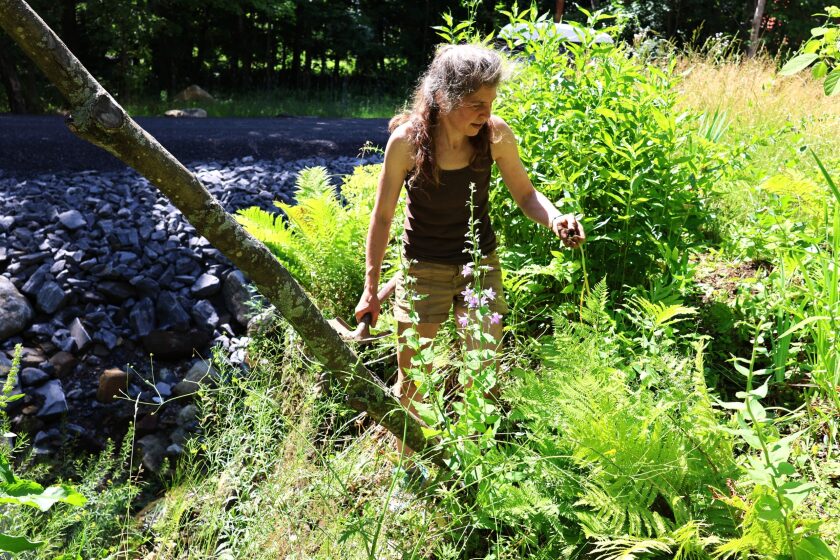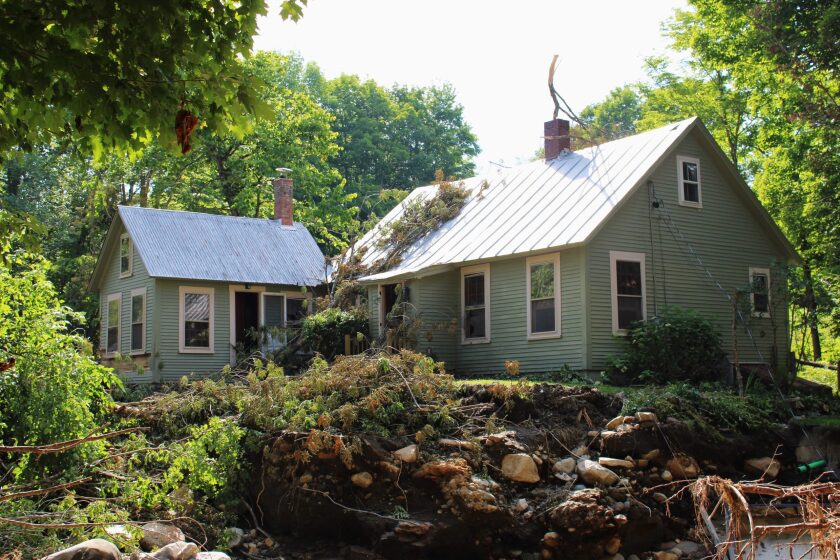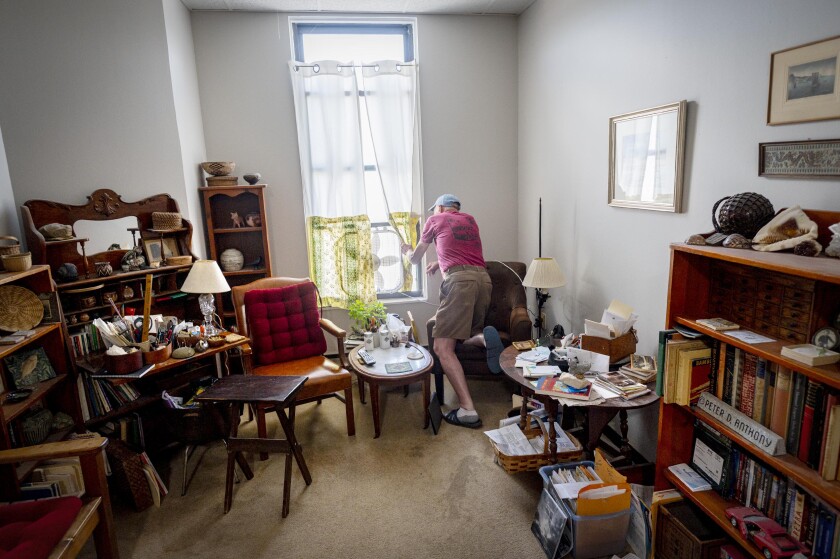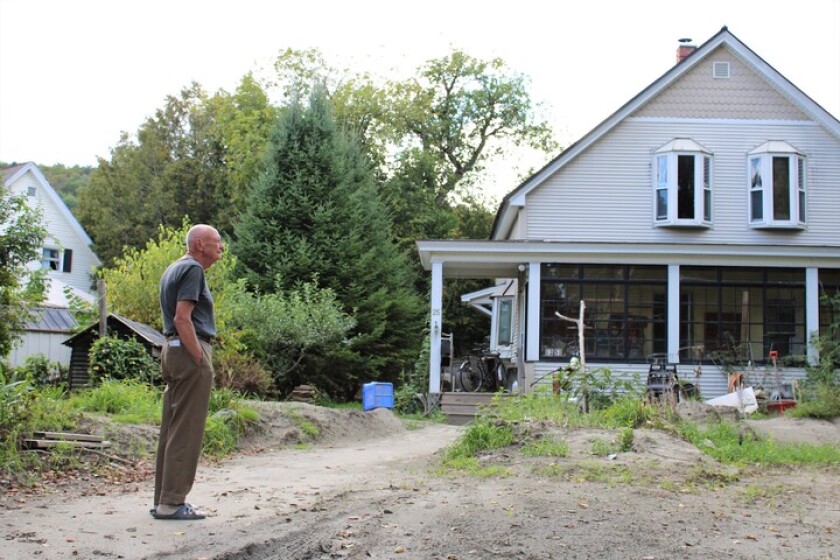PEACHAM — The green clapboard house where Jenny Mackenzie lived for over two decades sits boarded up and ghostly along a narrow gravel road in the Northeast Kingdom. Late one night last July, the brook that once snaked lazily around the property frothed into a raging river, jumping course. Mackenzie’s family of four escaped before their home was inundated. They haven’t lived here since.
On a sunny morning nearly a year after the flood, Mackenzie returned with a shovel and a trunk full of empty flower pots. She was here to salvage some of her once sprawling gardens. Much of what had bloomed here had simply disappeared; the lawn had collapsed into the brook, leaving a gaping hole. Yet Mackenzie was determined. She scaled down the steep ledge above the water, hanging onto a root for balance.
“Operation rescue!” she called out, grasping for a piece of a mallow plant. “Just one little piece, but it’ll spread.”
Last summer’s flood wasn’t the first to hit the property. In 2011, Tropical Storm Irene compromised the home’s foundation. So the family poured over $100,000 into flood-proofing the house, fortifying its base, along with replacing its electric and heating systems and repairing its well. Federal disaster grants and loans helped cover some of the costs, but Mackenzie didn’t recall any officials suggesting her family apply for a buyout. She painstakingly replanted her flower gardens.

(Photo by Carly Berlin VTDigger/Vermont Public)
But as far as Mackenzie knows, that day is still far in the future — another year from now, at least. Hands covered in silt and dirt, she paused to consider the long task ahead.
“I guess I get another summer to come dig things out,” she said.
'On the Edge of a Knife'
After historic flooding swept through Vermont in 2023 and 2024, hundreds of property owners applied for buyouts to try and get compensated for homes and businesses they would likely struggle to sell.
Vanishingly few have happened yet. State officials are currently overseeing 264 FEMA buyout applications. Of those, only eight property owners have gotten their payouts so far. Zero demolitions have occurred as of mid-July 2025, according to data provided by Vermont Emergency Management.
“It feels like a very low number, two years out,” said Stephanie Smith, the state hazard mitigation officer for Vermont Emergency Management.

(Photo by Carly Berlin/VTDigger and Vermont Public)
But Smith’s team, which manages federal buyout applications on behalf of Vermont cities and towns, had worked hard to speed things up, she said. Streamlining the application process on the state’s end helped cut down FEMA’s review period from a year and a half to about three months, as of this past winter, Smith said.
Soon after President Donald Trump took office, though, roadblocks started to arise. In February, applications that Smith expected FEMA to greenlight relatively quickly sat idle for months. Meanwhile, the Trump administration began reviewing the efficacy of FEMA programs; more than $100 billion in FEMA grant payments were frozen, and grant approvals stalled, according to reporting from the New York Times. (FEMA’s press office declined an interview request for this story, and did not answer detailed questions from VTDigger/Vermont Public).
This spring, FEMA started sending out approval letters again. But then came the next hurdle: It began quietly changing its rules for authorizing buyout applications, raising the bar on which projects it approves, Smith said. In early April, the agency, at the direction of the Trump administration, altered which projects it views as cost-effective, according to a mid-June press release.
“We were like … OK, here’s a giant brick wall. Deep breath, what do we do?” Smith said. “We don’t want to have to tell people that they’re not going to get buyouts. We told them they were going to get buyouts.”
Asked why the agency opted to make this change, FEMA’s press office said in a statement – attributed to an unnamed spokesperson — that hazard mitigation decisions are “policy informed.” The Trump administration is monitoring the approval of hazard mitigation funding, “with states’ ability to execute those funds,” the statement said.
“To date, we are observing large unobligated balances across the board. We are working with states to assist them in identifying projects and drawing down balances in a way that makes the nation more resilient.”
When state officials learned of the cost rule change in late May — prior to its official announcement — they scrambled to rework all the applications they were getting ready to send to FEMA, along with ones currently under the agency’s review, Smith said.
Almost 100 retooled applications later, all are still in the pipeline, for now. But Smith doesn’t feel relieved. If an already-approved application were to need any kind of tweaking, it would suddenly need to comply with different rules. For people still awaiting a decision from FEMA, that lengthy undertaking has slowed down. And given the Trump administration’s calls to eliminate FEMA and devolve its functions to states, everything seems precarious.
“It feels like we’re on the edge of a knife a little bit, and toggling … and just trying to keep everything balanced,” Smith said.

Glenn Russell(Photo by Glenn Russell/VTDigger)
'We're All Nervous'
Hundreds of Vermonters are caught in that balance. Many are waiting to hear whether FEMA will advance their applications. Many others have cleared that step, but are biding their time before the money finally arrives — and navigating tricky financial decisions in the meantime.
Peter Anthony, a former state representative for Barre City, had owned his home on Scampini Square for nearly 50 years. The July 2023 flood totaled it, and more flood damage came a year later, he said. Anthony and his wife have lived in a small downtown apartment since August 2023, which FEMA rental assistance helped pay for until January.
Two years after applying, Anthony recently received indication that his buyout is finally near the finish line. He expects to sit down and sign the closing paperwork later this summer.
Yet he doesn’t expect the payout to solve his financial woes. Anthony wants to buy another home in Barre. But the appraisal he received through the buyout process — which is pegged to the home’s pre-flood value — is $175,000, Anthony said, an amount that would “maybe buy half a house” in the current market. And he isn’t getting any younger.

(File photo by Carly Berlin/Vermont Public/VTDigger)
“How many mortgages can you get when you’re 81 years old for a house that you want to buy?” Anthony said.
To the east in Peacham, Rachael Moragues is also waiting on the money. She lived next door to the Mackenzies with her two sons, and they’ve bunked up at a friend’s house in neighboring Barnet since the flooding in 2024 rendered their home uninhabitable. Each month, Moragues still makes a mortgage payment on a house she’ll never live in again, she said.
She’s keeping an eye on the fate of FEMA. If for any reason her buyout doesn’t go through, she’d need to file for bankruptcy to pay off the house, she said.
“We’re all nervous because FEMA is one of those agencies that may or may not receive funding in the future,” Moragues said.
‘A Really Big Risk’
Looking at her old, boarded-up home, Mackenzie said she worries about what Trump’s calls to cut FEMA will mean for families like hers across the country. But she knows she’s relatively fortunate.
Friends crowdsourced enough money for her family to pay off the mortgage on their Peacham home after the flood, along with the loan they had to pay for the flood-fortification work post-Irene. They had just enough left over to put a down payment on a home in Craftsbury, she said.
The new house is over 30 miles away — and their monthly mortgage payment is close to triple what it had been for the old house. The home is too expensive for Mackenzie and her husband, both teachers, to afford long-term, she said. They took the leap even before they learned they’d gotten the buyout approved, to ensure their 16-year-old twins would have a place to call home before they move away for college.
“It was a really, really big risk for us to move there,” Mackenzie said. “The buyout is completely necessary in order to refinance, to get our mortgage to a level around where this one was.”
Mackenzie flipped open the trunk of her car, and filled it with daffodil bulbs and irises. She took off down the narrow gravel road. It was time to start planting at her new home.
This story first published in VTDigger. Read the original here.








